Diversity Collection
Integrated Pest Managment
Preview
IPM is still in preview - feedback welcome
The Integrated Pest Management (= IPM) in the DiversityWorkbench is designed to support the recording and evaluation of IPM-related data. IPM
is organized via Tasks.
The taxon specific data are stored in DiversityTaxonNames.
DiversityCollection allows
- Monitoring of pests, bycatch etc. in resp. on
 Traps
Traps Collections
Collections Fascicles
Fascicles Specimens
Specimens
- Recording of
 Cleanings
Cleanings Treatments
Treatments Application of beneficials
Application of beneficials Sensor data
Sensor data
- Generation of
- Administration of sensors network and related data
- Hardware in the network like
 LoRaWAN gateways and routers
LoRaWAN gateways and routers Sensors in LoRaWAN/BluetoothLE network
Sensors in LoRaWAN/BluetoothLE network
 Battery status of hardware in network
Battery status of hardware in network
 Sensor data retrieved from Prometheus database
Sensor data retrieved from Prometheus database
 Collection: Handling the collections in the tree
Collection: Handling the collections in the tree
- Change to top collection: Change to the parent collection of the current top collection
- Add collection
 Taxa: Setting the selection of taxa shown in the interface
Taxa: Setting the selection of taxa shown in the interface
 Pests
Pests Bycatch
Bycatch Beneficials
Beneficials
 Settings: Showing additional options to document pests
Settings: Showing additional options to document pests
- Show pests outside traps
- Show pests on specimen
- Show pests on groups of specimen
Data
The tables below the inspection dates contain the results for pests and
bycatch. Optionally additional tables for pests on e.g. specimen can be included. The first column shows the group, the second the taxon with a
link to resources in DiversityTaxonNames. If you click
on the link the available resources will be shown (see below).
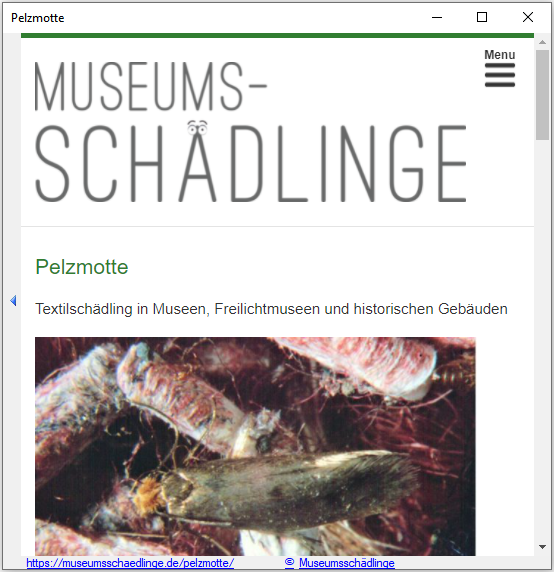
Column 3 shows preview of images in DiversityTaxonNames.
To see the original image together with additional images, click on the
preview image (see below).
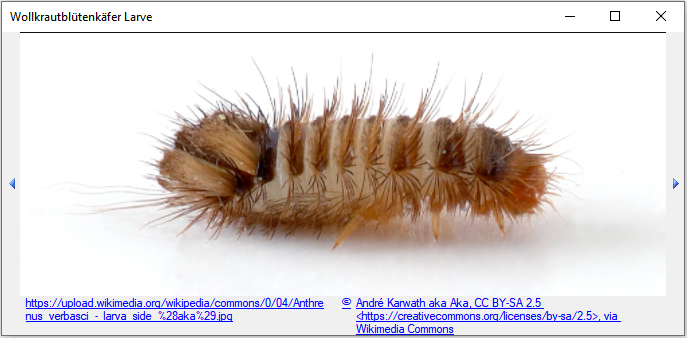
The next columns contain the counts of the taxa detected in the traps.
The acronyms of the traps within the collection
hierarchy are shown in the header. The numbers, states and notes for the taxa detected in the traps are
entered here as described in chapter Recording pests.
Subsections of IPM
Diversity Collection
Integrated Pest Managment
Charts
ToDo
Ausarbeitung erst wenn Verwendung klar ist
To generate a chart e.g. for the pests frequence, select the part of the collection tree for which the chart should be created for. Then in the  Chart tab click on the
Chart tab click on the  Generate chart button. A chart will be generated. To see the chart in a separate window, click on the
Generate chart button. A chart will be generated. To see the chart in a separate window, click on the  Show chart button. With the
Show chart button. With the  Save button you can save the generated chart as a png image and with the
Save button you can save the generated chart as a png image and with the  Export button you can export the data corresponding to the chart as a text file. The
Export button you can export the data corresponding to the chart as a text file. The  Open directory will open the directory that contains the exported file.
Open directory will open the directory that contains the exported file.
In the  Settings tab …
Settings tab …
In the  Metrics tab …
Metrics tab …
Diversity Collection
Integrated Pest Managment
Tutorial
To start with IPM, select Grid - IPM from the menu. If you open the window for IPM the first time, a window as shown below will open where you have to select the organisms etc. you want to record. It is recommended to start with only those pests you know that exists in your collection and add more pests when they are found.
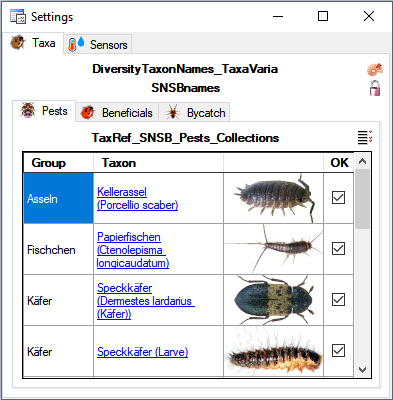
After setting the selection for the organisms you may get the message, that so far no traps had been defined
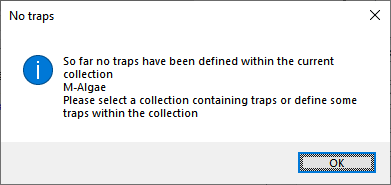
After this message the window for the collection management will open, where you can define the traps used in your collection. IPM is handled depending on the locality, so you have to change the display in the window from  administrative to
administrative to  location (see chapter Location for details). Here you can add traps in e.g. the rooms. Another option is to use the import wizard.
location (see chapter Location for details). Here you can add traps in e.g. the rooms. Another option is to use the import wizard.
Diversity Collection
Integrated Pest Managment
Recording pests
To insert a new recording or edit an existing one, click in the correspondig cell of the table. A window as shown below will open where you can enter the number of observed pests, their state (provided the state is present) and any notes.
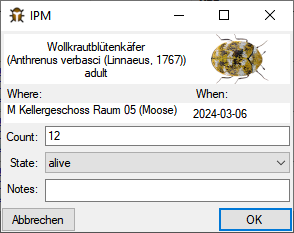
Subsections of Recording pests
Diversity Collection
Integrated Pest Managment
Bycatch
Along with the pests you may find organisms that are no threat for the collection but should be monitored anyway. To include these organisms, click on the  Bycatch button in the IPM form or choose Administration -
Bycatch button in the IPM form or choose Administration -  Collection tasks -
Collection tasks -  IPM -
IPM -  Taxa, Settings from the menu. A window will open where you can choose the organisms that should be recorded. See chapter Settings for details.
Taxa, Settings from the menu. A window will open where you can choose the organisms that should be recorded. See chapter Settings for details.
Diversity Collection
Integrated Pest Managment
Outside traps
ToDo
Ausarbeitung erst wenn Verwendung klar ist
You can record pests outside traps in the  Pests ouside traps. If the tab
Pests ouside traps. If the tab  Pests ouside traps is not shown in the IPM form, choose Settings -
Pests ouside traps is not shown in the IPM form, choose Settings -  Show pests outside traps from the menu or click on the
Show pests outside traps from the menu or click on the  Settings button to open the settings. See chapter Settings for details.
Settings button to open the settings. See chapter Settings for details.
With the  Add a collection where pests had been detected button you can add the corresponding part of your collection. A table column for the selected collection will be inserted and you can enter your data. With the
Add a collection where pests had been detected button you can add the corresponding part of your collection. A table column for the selected collection will be inserted and you can enter your data. With the  Details button you can inspect the details of the selected collection.
Details button you can inspect the details of the selected collection.
Diversity Collection
Integrated Pest Managment
Specimens
ToDo
Ausarbeitung erst wenn Verwendung klar ist
If pests are observed on a specimen this can be documented in the  Pests on specimem tab. With the
Pests on specimem tab. With the  Add a specimen where pests had been detected button you can add the corresponding specimen. A table column for the selected specimen will be inserted and you can enter your data. With the
Add a specimen where pests had been detected button you can add the corresponding specimen. A table column for the selected specimen will be inserted and you can enter your data. With the  Details button you can inspect the details of the selected specimen.
Details button you can inspect the details of the selected specimen.
If the tab  Pests on specimen is not shown in the IPM form, click on the
Pests on specimen is not shown in the IPM form, click on the  Settings button to open the settings. See chapter Settings for details.
Settings button to open the settings. See chapter Settings for details.
Diversity Collection
Integrated Pest Managment
Specimen groups
ToDo
Ausarbeitung erst wenn Verwendung klar ist
If pests are observed on a group of specimens like convolutes, fascicles etc. this can be documented in the  Pests on groups of specimem tab. With the
Pests on groups of specimem tab. With the  Add a group of specimen where pests had been detected button you can add the corresponding groups of specimens. A table column for the selected group of specimen will be inserted and you can enter your data. With the
Add a group of specimen where pests had been detected button you can add the corresponding groups of specimens. A table column for the selected group of specimen will be inserted and you can enter your data. With the  Details button you can inspect the details of the selected group of specimens.
Details button you can inspect the details of the selected group of specimens.
If the tab  Pests on groups of specimen is not shown in the IPM form, click on the
Pests on groups of specimen is not shown in the IPM form, click on the  Settings button to open the settings. See chapter Settings for details.
Settings button to open the settings. See chapter Settings for details.
Diversity Collection
Integrated Pest Managment
Settings
Taxa
To set the taxa shown in the form, click on the  settings button or choose Administration -
settings button or choose Administration -  Collection tasks -
Collection tasks -  IPM -
IPM -  Taxa, Settings from the menu. As window as below will open.
Taxa, Settings from the menu. As window as below will open.

There are 3 lists:
 Pests
Pests Beneficials
Beneficials Bycatch
Bycatch
Select the taxa that should be shown in the main form. The taxa used for IPM are by default taken from the public database DiversityTaxonNames_TaxaVaria provided via
tnt.diversityworkbench.de. If you want to set up your own list you can
change the source. Click on the  DWB button to set
the server and database, the
DWB button to set
the server and database, the  button to set the
project within your database and the
button to set the
project within your database and the  buttons
for every list to set the lists.
buttons
for every list to set the lists.
Display options
In the tab Display options you can choose
- If the scientific names should be shown in the interface
- If the collections other then traps (e.g. rooms) should be available for recording of pests
- If the specimens should be available for recording of pests
- If the convolutes, fascicles etc. should be available for recording of pests
With the  Reset taxa button you can requery the taxa from DiversityTaxonNames to get the latest lists.
Reset taxa button you can requery the taxa from DiversityTaxonNames to get the latest lists.
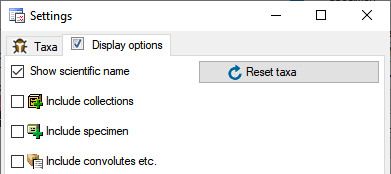
Diversity Collection
Integrated Pest Managment
Taxa
The IPM (Integrated Pest Managment) uses DiversityTaxonNames as a
backbone for Taxa. By default the public available database
DiversityTaxonNames_TaxaVaria on the server tnt.diversityworkbench.de is
used as a source. If you want to build your own source, you have to
follow the guidelines below to ensure the functionallity of the forms.
Resources
Preview images
The form for handling IPM data in DiversityCollection shows preview images for the objects like pests as shown below.

These preview images are retrieved from the corresponding lists in DiversityTaxonNames. To create these previews, choose a source, align it, remove the
background and reduce the size to 50 (height) x 100 (width) pixel.

Insert the preview image as a resource (see above) with the Type preview
(see below). The title of the image must correspond to the stage resp. remain as defined in the taxon list. If the preview image is taken from a foreign source you shoud enter the source, copyright etc. of image (see below).

Images
The original image of the preview should be included as as second image
with coresponding data but Type image (see below). These images will be
shown if the user clicks on the preview image in the table. You may add
additional images.

Resources
Resources that should be shown when the user click on the link in the
second column are added as shown below with the type information.

Group
The group shown in the interface is retrieved from the list entries with the IPM - group marker where the value defines the sequence for the corresponding groups. These are shown in the first column of the IPM form.
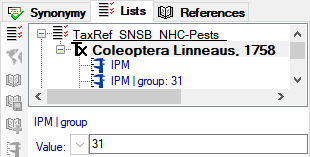
Common names
The first common name for the organisms or higher taxa are used for
display in the IPM form. Please provide one common name
for every taxon.

Life stages, remains
The life stages and remains of a taxon defined in DiversityTaxonNames) (see below).
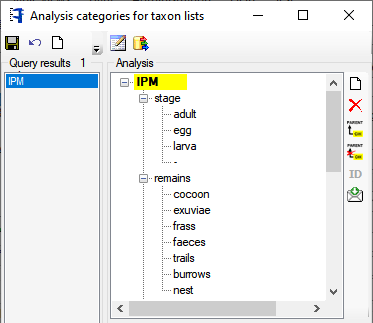
To make them available in DiversityCollection they must be included in the corresponding list (see below).
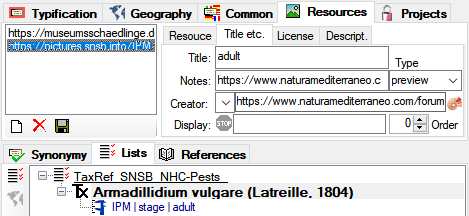
Diversity Collection
Integrated Pest Managment
Beneficials
ToDo
Ausarbeitung erst wenn Verwendung klar ist
If you apply an beneficial organism in your collection, you can document the taxon, source, location etc. in the application. In the IPM-form select the tab for the  Beneficials.
Beneficials.
In the collection hierarchy select the part (e.g. a room) where the beneficial organism has been applied. Next click on the  add button to add a benefical. If so far no benefical has been defined, the program will ask you if one should be defined. See chapter Settings for details.
add button to add a benefical. If so far no benefical has been defined, the program will ask you if one should be defined. See chapter Settings for details.
Diversity Collection
Integrated Pest Managment
Traps
Traps consist of two parts. One part is defined in the collection management including the position of the trap. The second part is e.g. the adhesive foil for catching the pests. The existing traps are shown in the collection hierarchy (see below)

If you add e.g. a pest taxon to a trap and so far no second part (= e.g. the adhesive foil) exists, the program will ask you for adding this part and insert the taxon there.
Diversity Collection
Integrated Pest Managment
Treatments
If you apply a treatment in your collection, you can document the location etc. in the application. In the IPM-form select the tab for the  Treatment.
Treatment.
In the collection hierarchy select the part (e.g. a room) where the treatment has been applied. Next click on the  add button to add a treatment. If so far no treatment has been defined, the program will ask you if one should be defined.
add button to add a treatment. If so far no treatment has been defined, the program will ask you if one should be defined.
ToDo
Ausarbeitung erst wenn Verwendung klar ist
Diversity Collection
Integrated Pest Managment
Cleaning
ToDo
Ausarbeitung erst wenn Verwendung klar ist
If you apply a cleaning in your collection, you can document the location etc. in the application. In the IPM-form select the tab for the  Cleaning.
Cleaning.
In the collection hierarchy select the part (e.g. a room) where the cleaning has been applied. Next click on the  add button to add a cleaning. If so far no cleaning has been defined, the program will ask you if one should be defined.
add button to add a cleaning. If so far no cleaning has been defined, the program will ask you if one should be defined.
Diversity Collection
Integrated Pest Managment
Collections
If no top collection is set, the program will ask you to select a top collection. You can change the top collection with the button at the top showing the top collection or as described below.
The Collection tree at the left part shows an overview of the current collection.
The top collection can be set by the user. Choose a collection in the tree you want to set as starting point.
A button will appear above the tree, e.g.  Set room ….
After setting a new starting point all data will be restricted to the selected collection and its inferior objects.
To return to a superior collection, click on the
Set room ….
After setting a new starting point all data will be restricted to the selected collection and its inferior objects.
To return to a superior collection, click on the  Change to parent collection button.
Change to parent collection button.
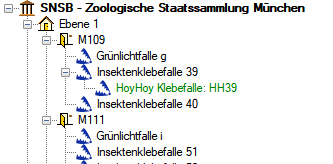
Diversity Collection
Integrated Pest Managment
Dates
Inspection dates
The Inspections show the previous
dates for inspections of the traps. The current date will be added at
the end of the list. If you want to add a date that is missing in the
list, click on the  add button. You may restrict the
range of the dates with a click on the
add button. You may restrict the
range of the dates with a click on the  button.
A window as shown below will open, where you can set the upper and / or
lower border of the range.
button.
A window as shown below will open, where you can set the upper and / or
lower border of the range.
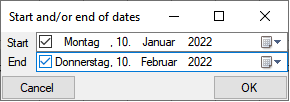
The lower and/or upper border will then be shown underneath the list for
the dates (see below).

To edit a border, just click on it and edit the value in the window that
will open. To remove a border use the  delete button.
delete button.
Diversity Collection
Integrated Pest Managment
Images
Images can be added for whole traps as well as details within traps where you can specify the area within the whole image of a trap where the detail image is taken from as shown in the example below.
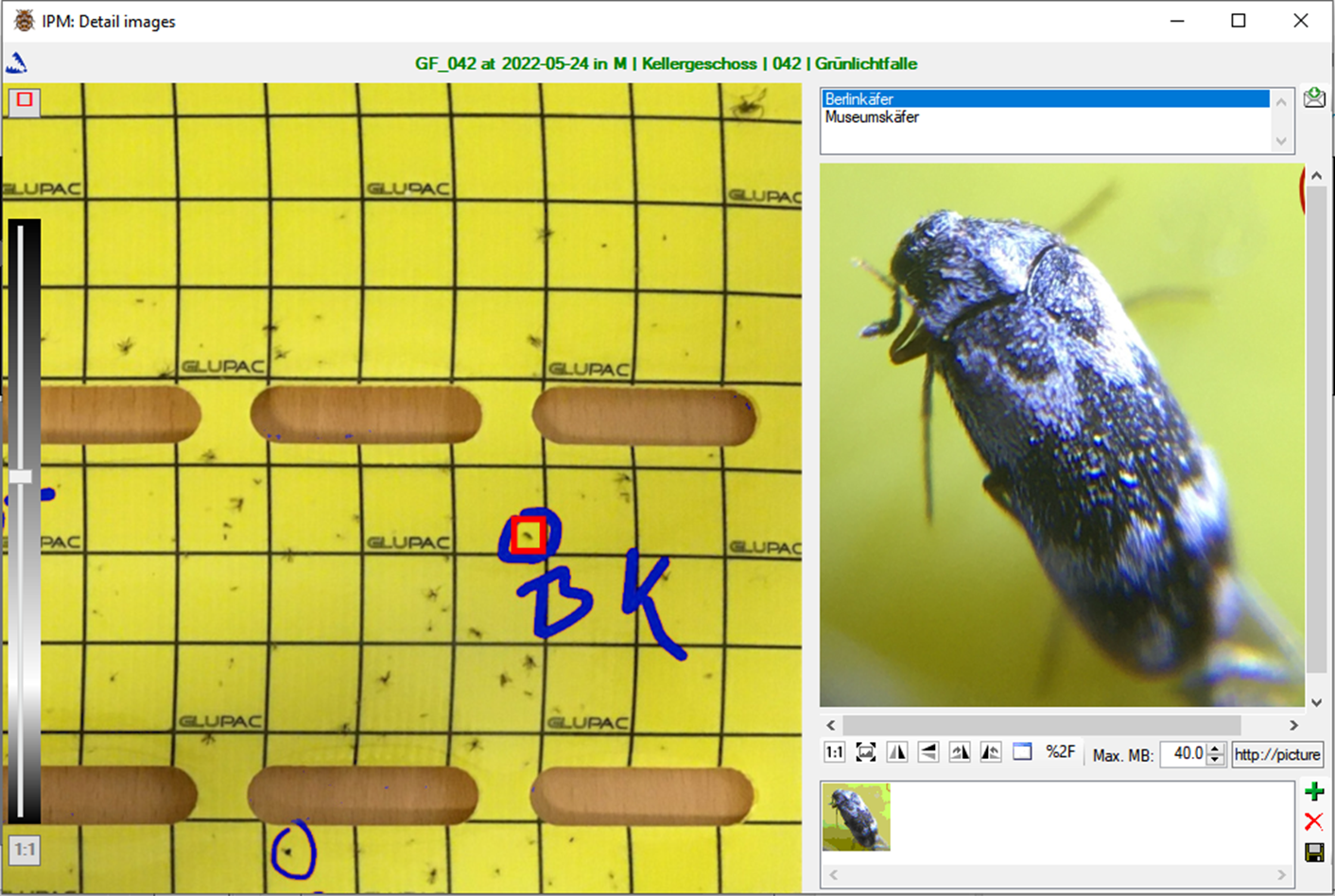
ToDo
Ausarbeitung erst wenn Verwendung klar ist
Diversity Collection
Integrated Pest Managment
Plans
ToDo
Ausarbeitung erst wenn Verwendung klar ist
You can provide floor plans for your collection and
pinpoint the locations or your sensors, traps etc.
Diversity Collection
Integrated Pest Managment
Report
ToDo
Ausarbeitung erst wenn Verwendung klar ist
Reports can be created in the  Report tab.
Report tab.
The collection hierarchy selects the part (e.g. a room) for which the report will be created. You can choose the time range for the report.
If no Schema is selected plain xml will be generated. With the  open file button choose a schema applied for the report. There are several schemas provided by the software, but you can create some of your own. You can include charts for either locations or
open file button choose a schema applied for the report. There are several schemas provided by the software, but you can create some of your own. You can include charts for either locations or  rooms and
rooms and  plans of your collection.
plans of your collection.
To create the report, click on the  create report button. To print it, use the
create report button. To print it, use the  button.
button.
Diversity Collection
Integrated Pest Managment
Sensor data
Prometheus
Installation of Prometheus
To install a Prometheus follow the guidlines provided on the
homepage.
server choose  from the menu.
from the menu.
Configuration of Prometheus
To configure a Prometheus server choose  from
the menu.
from
the menu.
Starting of Prometheus
To configure a Prometheus server choose  from
the menu.
from
the menu.
Naming conventions for Prometheus nodes
The nodes/sensors on the prometheus should be named according to the
follwoing convention: [Domain]_[MAC]_[Type]_[Units].
- Domain: e.g. IPM
- MAC: MAC of the sensor written without the : and in lower case
e.g. 00a49484b3f0 for 00:A4:94:84:B3:F0
- Type: The type of the sensor, e.g. temperature, battery, humidity
- Units: The measurement units of the metric, e.g. celsius, ratio
some examples:
IPM_3453a5f60087_battery_ratio
IPM_3453a5f60087_humidity_ratio
IPM_3453a5f60087_temperature_celsius
An examplethe o configure a Prometheus server choose  from the menu.
from the menu.
Diversity Collection
Integrated Pest Managment
Architecture
---
title: Taxa
---
graph TD;
DTN(DiversityTaxonNames) -->|Transfer extract of valid data in cache table<br>procFillTaxonName_Cache| CacheTable[Table <u>TaxonName_Cache</u><br>NameID int<br>JSON nvarchar]
CacheTable --> API
API --> Lists{separation of data <br>according to Lists}
Lists --> Pests[Pests]
Lists --> Bycatch[Bycatch]
Lists --> Beneficials[Beneficials]
Pests --> UPests[User selects pests<br>present in collection<br>Selection is stored in app]
Bycatch --> UBy[User selects taxa<br>that should be recorded<br>Selection is stored in app]
Beneficials --> UBene[Selected along with<br>application in collection]
Data recording
IPM covers several areas as shown in the mindmap below
mindmap
IPM
::icon(fa fa-bug)
Lists of Taxa
::icon(fa fa-list)
API: JSON
::icon(fa fa-cloud)
DTN
::icon(fa fa-database)
Floor plan
::icon(fa fa-map)
Prometheus time series database
::icon(fa fa-fire)
Sensors
::icon(fa fa-thermometer-half)
Traps
::icon(fa fa-cat)
Treatment
::icon(fa fa-broom)
Taxa
API
The taxon lists are provided by the module DiversityTaxonNames. The data are collected in a cache table and provided via an API as json. The module provides 3 lists.
mindmap
DTN
::icon(fa fa-database)
Cache
::icon(fa fa-table)
API: JSON
::icon(fa fa-cloud)
Pests
::icon(fa fa-list)
Bycatch
::icon(fa fa-list)
Beneficials
::icon(fa fa-list)
Local lists
The taxa are sorted according to their hierarchy including their stages etc. In the user interface the taxa are grouped according to group defined in DTN that correspond to higher taxa. From every list the user can decide which taxa and their stages, remains etc. should be included in the local list for selection
mindmap
DiversityTaxonNames containing Taxa
::icon(fa fa-database)
Cache containing JSON extract of valid taxa
::icon(fa fa-table)
API: JSON
::icon(fa fa-cloud)
Taxa as provided by API
::icon(fa fa-list)
Sorting according to hierarchy
::icon(fa fa-sitemap)
Local list as selected by the user
::icon(fa fa-check-square)
Plan
The floor plan for the collection provides the position of traps and sensors within the collection.
mindmap
Floor plan including scale
::icon(fa fa-map)
Rooms within the collection. Calculation of area and volume on base of scale
::icon(fa fa-vector-square)
Sensors and routers and their position
::icon(fa fa-thermometer-half)
Position of traps
::icon(fa fa-cat)
Traps
mindmap
Trap
::icon(fa fa-cat)
Position according to plan
::icon(fa fa-map-marked-alt)
Position within the collection hierarchy
::icon(fa fa-database)
Type of the trap
::icon(fa fa-newspaper)
ID corresponding to trap
::icon(fa fa-barcode)
Adhesive sheets
::icon(fa fa-border-none)
ID for every adhesive sheet
::icon(fa fa-barcode)
Collecting the data
::icon(fa fa-user)
Mobile application
::icon(fa fa-mobile)
Images of whole trap
::icon(fa fa-images)
Images of single pests
::icon(fa fa-search)
Images of previous samplings
::icon(fa fa-file-image)
Sensors
mindmap
Sensor
::icon(fa fa-thermometer-half)
Device collecting bluetooth signals of sensors
::icon(fa fa-microchip)
LoRaWan sender forwarding the sensor data
::icon(fa fa-broadcast-tower)
Receiver collecting data and storing data in a timeseries database
::icon(fa fa-wifi)
Application transferring data from timeseries databases in central database
::icon(fa fa-database)
Report
Reports provide a summary of all IPM related data in a certain time range
mindmap
Report
::icon(fa fa-list)
Development over time
::icon(fa fa-chart-bar)
Sensor data: Temperature, Humidity, ...
::icon(fa fa-thermometer-half)
Pests
::icon(fa fa-bug)
People involved in administration and in collecting the data
::icon(fa fa-users)
Floor plan including locations of traps and sensors
::icon(fa fa-map)
Treatments of the collection
::icon(fa fa-broom)
Traps
Collections
Fascicles
Specimens
Cleanings
Treatments
Application of beneficials
Sensor data
Reports
Charts
Plans
LoRaWAN gateways and routers
Sensors in LoRaWAN/BluetoothLE network
Battery status of hardware in network
Sensor data retrieved from Prometheus database
Collection: Handling the collections in the tree
Taxa: Setting the selection of taxa shown in the interface
Pests
Bycatch
Beneficials
Settings: Showing additional options to document pests


 Show chart button. With the
Show chart button. With the  Save button you can save the generated chart as a png image and with the
Save button you can save the generated chart as a png image and with the  Export button you can export the data corresponding to the chart as a text file. The
Export button you can export the data corresponding to the chart as a text file. The  Open directory will open the directory that contains the exported file.
Open directory will open the directory that contains the exported file. Metrics tab …
Metrics tab …


 administrative to
administrative to  location (see chapter
location (see chapter 
 Collection tasks -
Collection tasks - 
 Add a collection where pests had been detected button you can add the corresponding part of your collection. A table column for the selected collection will be inserted and you can enter your data. With the
Add a collection where pests had been detected button you can add the corresponding part of your collection. A table column for the selected collection will be inserted and you can enter your data. With the  Add a specimen where pests had been detected button you can add the corresponding specimen. A table column for the selected specimen will be inserted and you can enter your data. With the
Add a specimen where pests had been detected button you can add the corresponding specimen. A table column for the selected specimen will be inserted and you can enter your data. With the 
 Add a group of specimen where pests had been detected button you can add the corresponding groups of specimens. A table column for the selected group of specimen will be inserted and you can enter your data. With the
Add a group of specimen where pests had been detected button you can add the corresponding groups of specimens. A table column for the selected group of specimen will be inserted and you can enter your data. With the  DWB button to set
the server and database, the
DWB button to set
the server and database, the  buttons
for every list to set the lists.
buttons
for every list to set the lists.  Reset taxa button you can requery the taxa from DiversityTaxonNames to get the latest lists.
Reset taxa button you can requery the taxa from DiversityTaxonNames to get the latest lists.











 Change to parent collection button.
Change to parent collection button.



 delete button.
delete button.

 create report button. To print it, use the
create report button. To print it, use the 